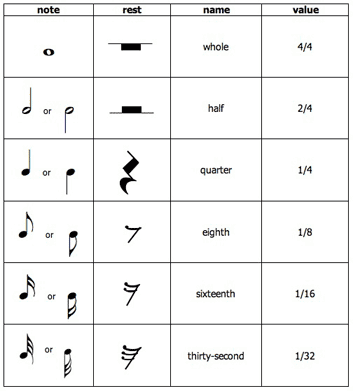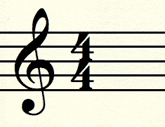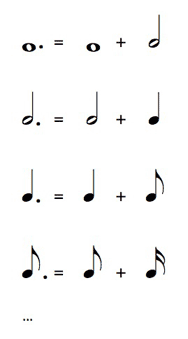notation (time)
As you can imagine, there are different symbols to indicate the duration of a note, and there are also symbols that represent silence, they are called 'rests': let's have a look at them
it probably does not mean much to you now, but it will in a minute. First of all, let's say that the longest note is a whole, and every following notes last half of the time of the previous, and this is pretty clear by their names... The rests last exactly as the corresponding notes. Further submultiples are also in use (64ths and 128ths) but are less common. Of course this is not an absolute measure, we can't really tell how many seconds a note lasts; in order to be able to give a precise duration to a note, we need to introduce a first concept, the meter:
the meter is basically the regular sequence of strong and weak beats of equal duration. The meter is represented by a fraction next to the clef:
The numerator tells us how many beats are in one bar (in these case 4), the denominator tells us the value of one beat (in this case 1/4). We can read this meter as 'there are four beats of a duration of one quarter in each bar'.
With the exception of the first bar, every bar must contain the same amount of beats, in this case 4/4
Within a bar, the beats are not equal: some are stronger and some weaker, which contributes to give the rhythm more sense. The structure of a 4/4 bar is
With the help of a metronome, an instrument that generates beats of equal duration, we will now examine the duration of each of the symbols. We are going to listen to eight beats first, so that we can get the rhythm, and then we will listen to the note with the metronome in the background. The first beat of each bar sounds different to help us keep track of the bars more easily. Ready?
Numerators like 2, 3 or 4 over denominators like 2 or 4 indicate a simple meter, where each beat is divided into two sub-beats.
Numerators like 3, 6 or 9 over denominators like 8, 9 or 12 indicate a compound meter, where each beat is divided into three sub-beats.
Let's listen to a compound beat: to better understand the subdivision in three sub-beats, they are audible in the metronome:
One last symbol we need to see is the dot: a not followed by a dot is extended by half of its value.
The meter, however, is not the only indicator of the absolute length of a note, in facts, it does not indicate it at all if we do not attach a time value to the speed at which the beats are played. Such indication is called tempo, and it is expressed in beats per minute, or as you have probably heard of, BPM.
This measure indicates how many beats are played in a minute, therefore the higher it is, the faster will be our music piece.
Usually only whole BPM values are used, but there is nothing that prevents you to use a 143,5 BPM value if you wish. Modern metronomes allow the use of fractions of BPM.
From a BPM value, we can easily calculate how long is a beat, so that we can have an absolute reference of time to attach to our notes:
At 60 BPM:
A 4/4 note is 4 seconds long
A 1/4 note is 1 second long
A 1/8 note is 0,5 seconds long
A 1/16 note is 0,25 seconds long
We can easily find out the length of a 1/4 note using the formula:
1?4 note length = 60/BPM seconds
and then it is easy to calculate the length of its multiples and submultiples. This is not really frequent in music, usually one does not need to know such a value, but is much more useful to us sound engineers, if we want to calculate delay and reverbs times that are consistent with the musical piece. More about this well be said in the Processing section of this course.
Here are some examples of the same brief musical piece played at different BPM:
There are many other symbols used in musical notation to indicate intention, tempo changes, expression, variations, etc. It is beyond the scope of this course to examine them, so we will only limit to this.
Again, what makes the difference in understanding these concepts is practice: make sure you do lots of tests!

it probably does not mean much to you now, but it will in a minute. First of all, let's say that the longest note is a whole, and every following notes last half of the time of the previous, and this is pretty clear by their names... The rests last exactly as the corresponding notes. Further submultiples are also in use (64ths and 128ths) but are less common. Of course this is not an absolute measure, we can't really tell how many seconds a note lasts; in order to be able to give a precise duration to a note, we need to introduce a first concept, the meter:
the meter is basically the regular sequence of strong and weak beats of equal duration. The meter is represented by a fraction next to the clef:

The numerator tells us how many beats are in one bar (in these case 4), the denominator tells us the value of one beat (in this case 1/4). We can read this meter as 'there are four beats of a duration of one quarter in each bar'.
With the exception of the first bar, every bar must contain the same amount of beats, in this case 4/4
Within a bar, the beats are not equal: some are stronger and some weaker, which contributes to give the rhythm more sense. The structure of a 4/4 bar is
| beat | 1 | 2 | 3 | 4 |
| accent | strong | weak | half-strong | weak |
With the help of a metronome, an instrument that generates beats of equal duration, we will now examine the duration of each of the symbols. We are going to listen to eight beats first, so that we can get the rhythm, and then we will listen to the note with the metronome in the background. The first beat of each bar sounds different to help us keep track of the bars more easily. Ready?
Numerators like 2, 3 or 4 over denominators like 2 or 4 indicate a simple meter, where each beat is divided into two sub-beats.

Numerators like 3, 6 or 9 over denominators like 8, 9 or 12 indicate a compound meter, where each beat is divided into three sub-beats.

Let's listen to a compound beat: to better understand the subdivision in three sub-beats, they are audible in the metronome:
One last symbol we need to see is the dot: a not followed by a dot is extended by half of its value.

The meter, however, is not the only indicator of the absolute length of a note, in facts, it does not indicate it at all if we do not attach a time value to the speed at which the beats are played. Such indication is called tempo, and it is expressed in beats per minute, or as you have probably heard of, BPM.
This measure indicates how many beats are played in a minute, therefore the higher it is, the faster will be our music piece.
Usually only whole BPM values are used, but there is nothing that prevents you to use a 143,5 BPM value if you wish. Modern metronomes allow the use of fractions of BPM.
From a BPM value, we can easily calculate how long is a beat, so that we can have an absolute reference of time to attach to our notes:
At 60 BPM:
A 4/4 note is 4 seconds long
A 1/4 note is 1 second long
A 1/8 note is 0,5 seconds long
A 1/16 note is 0,25 seconds long
We can easily find out the length of a 1/4 note using the formula:
1?4 note length = 60/BPM seconds

and then it is easy to calculate the length of its multiples and submultiples. This is not really frequent in music, usually one does not need to know such a value, but is much more useful to us sound engineers, if we want to calculate delay and reverbs times that are consistent with the musical piece. More about this well be said in the Processing section of this course.
Here are some examples of the same brief musical piece played at different BPM:
There are many other symbols used in musical notation to indicate intention, tempo changes, expression, variations, etc. It is beyond the scope of this course to examine them, so we will only limit to this.
Again, what makes the difference in understanding these concepts is practice: make sure you do lots of tests!
